|
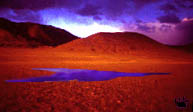
Sunset in Mongolian Altai.
Wild Mongolia
If you try a web-search for Mongolia, you'll find plenty
of companies advertising tours to this country. But virtually all these tours
are either hunting expeditions aimed on shooting tame animals in specially organized
hunting reserves (although customers think the animals are wild), or brief visits
to luxurious "field camps" with Internet access and English-speaking
"nomads" around. Both kinds of tours are extremely expensive and give
you no chance of seeing any "unprepared" Mongolian life. The only way
to see the real Mongolia is to travel on your own. It is not completely legal
for foreigners, but, as soon as you get out of the capital, nobody really cares.
If you don't mind spending long days travelling in overloaded trucks on dirt roads,
or on less bumpy grassland floor, breathing dust, drinking fermented milk, eating
almost nothing but meat for weeks, urinating in front of your fellow travelers
during brief road stops, driving 50 years-old trucks and buses, camping on road
junctions for days to wait for a passing car, and having wild sex with cute native
girls (these little Amazons can teach you how to do it while riding on horseback)
as part of local tradition of hospitality, you'll find Mongolia to be one of the
most pristine and captivating places on Earth.
|
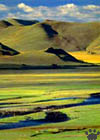
Onon River, Mongolia. |
For me, the most interesting thing about Mongolia is
the degree to which local Nature have been preserved. You can travel for days
and see almost no signs of human presence. It is probably the last non-African
country where you can observe large herds of various wild animals migrating freely
outside Nature reserves. (Few years ago it could also be said about Western Tibet,
but now its large mammals are mostly gone because of poaching. In other areas,
there is no more than one species existing in large numbers, like saiga antelope
in Kazakhstan or caribou in Canada). |
| Mongolia is the last place
where temperate grasslands still exist in their natural state. This type of vegetation
have once covered large portions of Eurasia, North America and Argentina. In our
days, shortgrass prairies (also called dry steppes) still survive in Patagonia,
The Great Plains and Kazakhstan (where they are mostly used
as pasturelands). But the most beautiful and productive grasslands, tallgrass
prairies (or blacksoil steppes) have all been converted into fields, except for
tiny nature reserves. Central and Eastern Mongolia is your last opportunity to
see the endless sea of emerald-green grass with no utility poles anywhere in sight. |

Grasslands,
Central Mongolia |
Mongolian feathergrasses: fluffy (upper left), Siberian
(upper right), splendid (lower left) and dwarf. |
Grasslands become especially beautiful in late spring,
when many species of bunchgrasses start spreading their seeds. Splendid (Stipa
pulcherrima), Siberian (S. zalesskii), fluffy (S. pennata) and
dwarf (S. capillata) feathergrasses turn Mongolian plains and foothills
into the endless silvery sea of soft, tender awns. Summers are not as dry here
as in other parts of Central Asia, so the grasses do not turn yellow until September. |
| The reason for such a good environmental condition is not the
absence of people. Mongolian grasslands have been populated for thousands of years.
Northern part of the country is dotted with ancient stone stelas, sculptures ("babas"),
burial mounds and ancient cities. Iranian, Altaic, Sino-Tibetan and many other
languages have all been spoken here as nomadic civilizations replaced one another.
The so-called Flint Valley has been used as a quarry since Stone Age - it is still
covered with hundreds of thousands of arrowheads and other stone tools. Some animals,
such as bison and woolly rhinoceros, became extinct, but many others survived,
thanks to some unique traditions and the preservation of nomadic lifestyle. |


Hun babas,
Hentei Mts. |

View from Bogdo Uul Mountain.
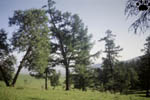
Giant larch trees, Bogdo Uul. |
Bogdo Uul mountain just outside Ulaan Baator, the capital
city, is one of the World's oldest Nature reserves - it have been considered sacred
for at least twenty centuries. Populations of Altai red deer (Cervus canadensis
altaicus), Siberian musk deer (Moschus moschiferus), Siberian ibex
(Capra sibirica), and other rare animals still exist in its forests. When
Genghis Khan, one of the greatest political and military leaders in history, was
a small boy Temujin, he had to hide in these forests from his enemies - he had
had a lot of them even than. (His life story was more interesting than any adventure
novel). Many other sacred mountains and valleys exist in Mongolia. Large Nature
reserves have been created during the last decade, some of them on these ancient
sites. |
| Mongolia is the only country where the majority of the population
is still nomadic. Outside few cities, almost everybody lives in gers (yurtas)
- large and comfortable tents with wooden frames. Even the capital, Ulaan Baator,
hadn't had a particular location until the 19th century. It consisted of large
and small gers, and was frequently moved from one place to another. Large part
of its population still lives in yurtas. However, even in nomadic times the city
had its own architect and was very beautiful. It is an interesting place to visit
- there is some beautiful architecture and excellent museums, including one of
the World's most spectacular paleontologic exhibits. |
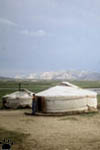
Mongolian gers. |
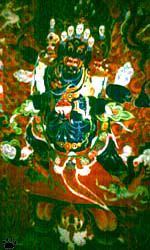
Colorful old murals in one of city
monasteries, Ulaan Baator.
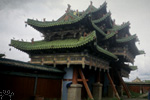
Most of old architecture is in Chinese
style with some Tibetan influence. |

Green Tara, work of
Zanabazaar, one of
Mongolia's greatest
artists (born in 1635).
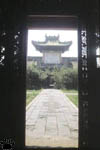
Part of monastery
entrance gates,
Ulaan Baator. |

Old mask made of coral,
gold and ebony, State
Museum of Arts, Ulaan
Baator.

Part of monastery
entrance gates,
Ulaan Baator. |
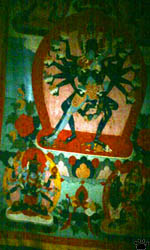
Erotic murals in Gandan monastery,
Ulaan Baator.
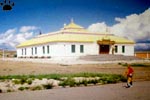
Only one building in unique
Mongolian, ger-like style is preserved. |
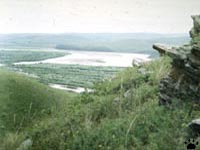
Kerulen River, Mongolia. |
Most of the country north of Ulaan Baator is mountains. Hangai
and Hentei, two high plateaus, rise here from the sea of grasslands. Kerulen and
Onon rivers make their way through beautiful meadows, rocky outcrops, and birch
forests, to join Amur River further east. This area is often considered to be
the birthplace of Mongol nation; many ancient songs and legends refer to Kerulen
basin when describing the adventures of folk heroes and khans. |
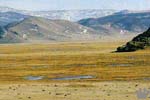
Tundrosteppes were widespread in
Siberia during Ice Age, but now they
exist only in Hangai Mountains
and on Vrangel Island off the
northern coast of Chukotka. |
Inside these labyrinths of ridges and valleys,
the nature resembles Siberia. There is even a local version of Lake
Baikal, a beautiful high-altitude lake called Hovsgol. There are some enemic
fish species in Hovsgol basin, such as Mongolian grayling (Thymallus brevirostris). |
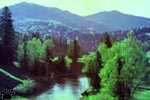
Taiga forests of Hentei Mountains
are a good place to see snow deer
(Capreolus pygargus), wolves,
brown bears, taiga reindeer (Rangifer
tarandus major), other Boreal fauna. |
| The far western part of Mongolia
is the highest mountain range of all - Mongolian Altai. It is separated from Khangai
by a chain of flat, dry valleys with a collection of lakes in them. Lakes range
in size and salinity from tiny fresh vernal pools to huge Uvs Nuur, a bitter inland
sea the size of Rhode Island. These valleys are inhabited by many interesting
animals, such as endemic lake vole (Microtus limnophilys). |
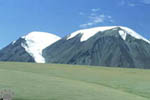
Mongolian Altai in early fall. |
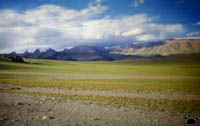
Mongolian Altai near Russian border - habitat of
argali sheep (Ovis ammon), gray marmot (Marmota
baibacina), Altai snowcock and white-throated bushchat. |

Rearview mirror
view of White Bom on Chuisky Tract. |
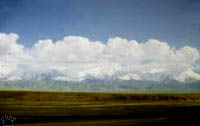
Bulnai Fault was formed during 1905 Gobi-Altai
earthquake, the strongest recorded in history. The
earthquake didn't cause any human fatalities. |
| The spectacular Chuisky Tract is the
only road that crosses the Altai Mountains and connects Western Mongolia with
Russian cities along the Transsiberian Railroad. This highway is infamous for
so-called boms - narrow cliff ledges, where truck drivers often perish when the
pavement is slippery. |

Valley of Big Lakes, Mongolia |
Mongolian lakes and mountains are one of the best places
in Asia to look for rare birds, such as white-throated bushchat (Saxicola insignis),
Altai snowcock (Tetraogallus altaicus), relict gull (Larus relictus),
white-necked crane (Grus vipio), Kozlov's accentor (Prunella kozlovi),
black stork (Ciconia nigra), Dahurian partridge (Perdix dauurica),
Pallas' sandgrouse (Syrrhaptes paradoxus), many larks, shorebirds, bustards,
finches, wheatears, and birds of prey. |

Demoiselle cranes (Grus
virgo) can be seen in the
Valley of Lakes in flocks
of up to 10,000 birds. |

Bar-headed goose (Anser
indicus) is the only goose
that often nests on rock
cliffs or even trees. |

In October this bar-headed
goose chick will cross
the Himalaya to get to its
wintering grounds in India. |

Lammergeyer(Gypaetus
barbatus), the largest
bird of prey in Asia, is
common in Altai Mts. |

Great black-headed gull
(Larus ichthyaetus) is
the most beautiful gull
in the World. |
Interesting mammals of Western Mongolia include Pallas'
cat (Felis manul), desert beaver (Castor fiber birulai), marbled
polecat (Vormela pereguzna), snow leopard
(Panthera uncia), desert weasel (Mustela altaica), Central Asian
bat (Eptesicus bobrinskoi), and corsac fox (Vulpes corsac). The
rarest of all is Mongolian saiga (Saiga tatarica mongolica). About 200
antelopes of this small, non-migratory subspecies survive in Yellow Gobi area
in the Valley of Big Lakes. It inhabits barren areas in dry depressions, former
lake beds, and salt plains. Unlike the widespread Kazakhstan subspecies (S.
t. tatarica), it was never studied by naturalists and is seldom observed in
Nature. The dim pictures below are probably the only photos ever taken in the
wild.
 |
 |
 |
 |
| Mongolian saigas: male,
female, pair and a group of 4. North from Shirgyn Gov', Mongolia. |
|
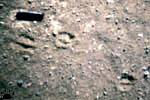
Tracks of Mongolian saiga (the knife
is 12 cm long).
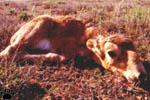
Newborn Kazakhstan saiga, Black
Lands Reserve, Kalmykia, Russia. |
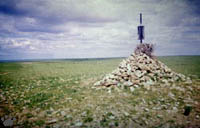
The so-called oboos are the most common signs
of human presence in the grasslands. They mark
passes, junctions and other prominent places.
Upland buzzards (Buteo hemilasius), steppe eagles
(Aquila nipalensis), sakers (Falco cherrug) and
other birds often nest on or near oboos. South
from Mandal Gov', Central Mongolia. |
East and south from Ulaan Baator the land is mostly
flat. This immense ocean of virgin grassland is what remains of the "Great
Steppe" - a grassland corridor that once stretched from Vienna to Beijing.
During the time of Mongolian Empire, it was all one civilized country with excellent
roads, so that Marco Polo and other travelers could get from Europe to China in
few months. But as soon as the empire had collapsed, the exchange of goods and
ideas between East and West stopped for a long time. Since the arrival of Buddhism,
the Mongols have never started a war again. Eventually, most of their territory
was lost to Russia and China. |
| Travelling in the grasslands is a nice adventure. Although cars
are rare and mostly overloaded, hitchhiking is very easy. If you are a foreigner,
locals usually assume that you can drive any kind of truck, bus or bike, so they
often ask you to drive while they rest. In many parts of the country, even a city
bus can be driven cross-country, and nobody minds if you chase antelopes or stop
to have a better look at something. You'll have to stop at every ger to let your
passengers talk to people there and have a drink (airag - fermented milk with
3-6% alcohol). |
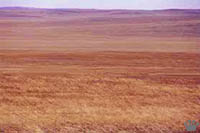
October in Eastern Mongolia. |

Zerens, Central
Mongolia. |

Harasults, South-
Central Mongolia. |

Hulans, Southern
Mongolia. |

Takhi, Khustain
Nuruu, Mongolia. |
|
Always keep your eyes open for wild animals. Zeren, or Mongolian
gazelle (Procapra gutturosa) can be seen in groups of up to five thousands.
A smaller ada, or Ordos gazelle (P. przevalskii), used to occur in southeastern
Mongolia, but now it only exists in Kukunor area, China. Both can run at 60 km
per hour, so be careful if trying to drive by. Further south, the harasult, or
Persian gazelle (Gazella subgutturosa) is more common. Hulan, or Asian
wild ass (Equus hemionus) is also widespread, mostly in the east and south.
Takhi, or Przhevalskii's horse (E. caballus przevalskii) have been reintroduced
to two Nature reserves. |
| Small mammals are equally interesting. Dozens of species of mice,
voles, jerboas, hamsters, lemmings and ground squirrels hide in tall grass. There
are also gerbils, mole voles, marmots, dormice and other rodents, pikas, hares,
shrews and a rare hedgehog (Mesechinus dauuricus). Some of Central Asian
rodents are now sold in pet stores throughout the world, but the cutest ones are
difficult to breed in captivity, so they can only be seen in the wild. |

Dwarf hamster (Phodopus
campbelli), Hovd, Mongolia. |

Long-eared jerboa, the
only photo ever taken
in the wild. Transaltai
Gobi, Mongolia. |
The most cute, interesting and diverse of Mongolian rodents are
jerboas. You can see them by driving or hiking at night in dry grasslands and
deserts. The large species, locally called alagdaaga (Allactaga, Allactagulus),
and smaller emuranch (Scirtopoda, Dipus) are easy to find, but tiny daahai
(Cardiocranius, Salpingotus) are shy and difficult to see. The most bizarre
of all, the long-eared jerboa (Euchoreutes naso), can only be found in
sand deserts along the Chinese border. |
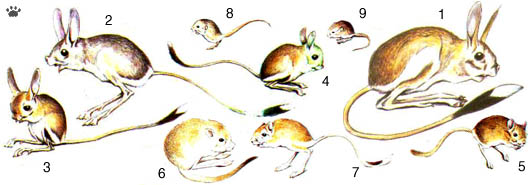
Some of Mongolian jerboas: Allactaga major (1), A. sibirica
(2), A. elater (3), Allactagulus pygmaeus (4), Scirtopoda telum
(5), S. andrewsi (6), Dipus sagitta (7), Salpingotus crassicauda
(8), Cardiocranius paradoxus (9). (From: V.Dinets, E.Rotshild. Mammals
of Russia. ABF, 1998.) |
| As you travel south, the grasslands become
more and more dry, and eventually turn into deserts. But to see the real Gobi
Desert - desolate, hot and beautiful - you have to cross the mountains of Gobi
Altai. |
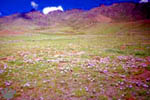
Foothills of Gobi Altai, Mongolia. |

Gurvan Saihan Ridge, Gobi Altai. |
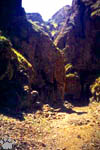 |
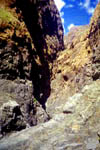 |
| Yolyn Am canyon, Gobi
Altai. |
|
Yolyn-Am (Lammergeyer Narrows) is the part of Gobi Altai most
foreign tourists see, as there is a large tourist camp close by. It resembles
geologically similar canyons of Death Valley,
California. This beautiful canyon is a good place to see rare Gobi sheep (Ovis
ammon darwini), and many other interesting animals and plants. Nesting birds
include wallcreeper (Trichodroma muraria) and cinereous vulture (Torgos
monachus), locally known as condor. All this mountain ridge is now part of
a large national park. |
| Southern foothills of Gobi Altai were once a shoreline of a shallow
sea not unlike Gulf of Mexico. Just as the Gulf today, they were lined by dense
baldcypress forests. Since than, giant "dinosaurs graveyards" exist
in Gobi. Fossils of softshell turtles (Tryonix) are more easy to find,
but dino bones are also scattered in many locations, despite collecting efforts
of many expeditions. Northern Mongolia, by the way, is also of great interest
for fossil hunters: many wonderful mammals have been found there, such as a giant
carnivore Hyenodon and giraffe-like megarhynoceros Indricoterium.
All these finds can be seen in the museum in Ulaan Baator. The most famous exhibit
is a fossil of Velosiraptor mongoliensis fighting with Protoceratops
andrewsii. There is also a pair of "hands" belonging to an unknown
dinosaur (named Deinocheirus mirificus), probably a carnivore twice the
size of Tirannosaurus rex. |
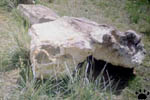
Petrified trunk of baldcypress
(Taxodium), Gobi Altai.
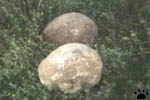
Eggs of Oviraptor dinosaurus,
Gobi Altai. |
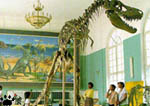
Tirannosaurus baatar,
Ulaan Baator. |
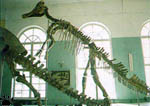
Saurolophus angustifrons,
Ulaan Baator. |
T. baatar, also known as Tarbosaurus efremovi,
was common in Mongolia in the late Cretaceous. It probably fed on Saurolophus
duckbills and other herbivores. It was the most spectacular fauna in the history
of our planet, but it was destroyed 65 million years ago. |
| Transaltai Gobi is the most "typical" part of the desert.
Its name is derived from Mongolian "gov'", that means a dry basin. Being
surrounded by old mountain ridges, Gobi is mostly covered with flat alluvial cones.
These "pebble seas" can be black, purple, gray or brown, and they are
very easy to drive across. But there are also badlands crisscrossed with small
canyons, soft beds of dry lakes, and sand dunes (the latter are mostly present
in central parts of basins, and they are much less common in Mongolia than in
Chinese parts of Gobi, such as in Gashun Gobi near Dunhuan). So, driving in Gobi
is always an adventure. The desert is mostly uninhabited, so it can be a good
idea to get a horse or a camel instead of a car - this way you'll never get stuck
anywhere without fuel. Besides, the undriveable parts of Gobi are often the most
beautiful ones. |

Transaltai Gobi - habitat of long-eared
hedgehog (Hemiechinus auritus).
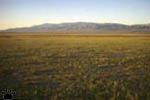
Northern Gobi - habitat of Mongolian
ground-jay (Podoces hendersoni). |
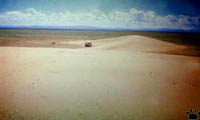
Jeep in Transaltai Gobi. Black-bellied sandgrouse
(Pterocles orientalis), and giant windspiders
(Ammotrechis giganteus) live in such places. |
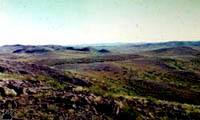
Badlands of Central Gobi - habitat of eagle owl
(Bubo bubo), desert green toad (Bufo viridis),
and steppe polecat (Mustela eversmanni). |
There are some interesting animals in Gobi, but they can be difficult
to find because of low population density. Many are nocturnal, despite the fact
that nights in Gobi are often very cold. |
| Probably because of cold nights, snakes are very rare in Gobi.
In addition to the two poisonous species shown here, there are also two dwarf
boas and three racers, but none is common. Two nocturnal species of lizards are
also rare, but diurnal ones are abundant. Hiking in Gobi in summer, you normally
see one lizard every minute or two. |

Small viper Vipera
ursini, Gobi. |

Pit viper Akgistrodon
pallasii, Gobi. |

Lizard Eremias
przhevalskii, Gobi. |

Lizard Phrynocephalus
versicolor, Gobi. |

Gecko Teratoscincus
przhevalskii, Gobi. |
Various small species of Eremias and Phrynocephalus
are the most common lizards in Mongolia. The only large lizard is Stolichki's
agama (Laudakia stoliczkana), rare inhabitant of some desert canyons. |
| Of all the large animals in Gobi, two are particularly difficult
to find: mazaalai, or Gobi bear (Ursus arctos ssp.), and havtgai, or wild
camel (Camelus bactrianus). There are only 20-40 bears left in Gobi, and
nobody knows exactly what they look like. Some scientists suggest that this relict
population belongs to Tibetan subspecies (U. a. pruinosus), others believe
that it is a Tian Shan bear (U. a. isabellinus). Its entire range is now
within nature reserves, but the population seems to be declining, probably because
of climate aridization. The wild camel is more numerous (a thousand or more left
in Gobi and Takla Makan deserts), but it inhabits the most remote and inhospitable
areas, so seeing this beautiful creature in the wild is a great luck (and, unlike
Przhevalskii's horse, it have never been obtained by any zoo). |


Wild camel, Gobi. |
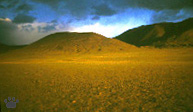
High plateau in Mongolian Altai.
Mongolian trip diary can be found here.
Home
|

